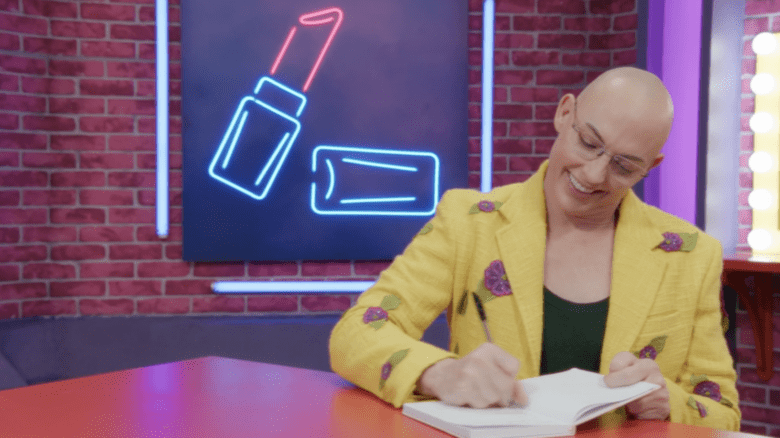When The L-Word first aired in 2004 it represented something huge for all dykes: an accessible image of a lesbian microcosm. Prior to the series TV’s lesbian characters seemed to be carefully controlled anomalies, isolated within mainstream scenarios.
Enter a woman with money and a dream, L-Word creator Ilene Chaiken, who birthed a virtual pussy munchkin that gobbled up the lesbian world.
The L-Word ran six seasons, the final episode airing on Mar 17. It followed the lives of a small group of tight-knit lesbian friends in Los Angeles and their struggles to find love, sex and themselves.
In the beginning we were wet with glee. To celebrate the arrival of characters Jenny, Marina, Shane, Alice, Dana, Tina and Bette lesbian toga parties took place all over the world where Hennessey was flowin’ like pussy juice.
Hyperbole aside The L-Word really gave us clit-flickers a reason to celebrate. Chaiken affirmed lesbians really do exist and deserve our hour on television too. No matter how unreflective the characters on the show were to the average, middle-class dyke, at least we were finally visible to the mainstream.
The first few seasons were the best. Chaiken explored ideas around sexuality through lead character Jenny Schecter, who moved to LA with her boyfriend and quickly became enticed by a smooth-talking Latina, Marina. We all remember our first girlcrush; finally we got to see one fulfilled in primetime with a passionate bathroom-scene kiss.
Then there was couple Bette and Tina and the exploration of desire through Bette’s affair with a hot carpenter and, after it was out in the open, its strain on her relationship with Tina.
Coming out in various social situations, being insecure about feelings in a sexual relationship, grappling with fidelity, these are issues queer women in my life deal with and I appreciated that Chaiken was willing to address them.
But while the show initially quenched my appetite for onscreen lesbian sex, as the seasons went on the show’s creativity began to crumble. Not even the novelty of lesbian characters could stir my excitement.
For the last two seasons it seemed the only thing I could relate to was how damn crazy lesbians can be with their estrogen levels skyrocketing, with feelings and their pussies pleading for a good licking. Does sleeping with a lesbian your friend has already drilled, gossiping about a friend behind her back or maybe even hissing at another dyke ring any bells? But that was the only hint of realism left to the show.
The show’s integrity slipped further when it introduced characters for the sake of tokenism, for example the introduction of trans character Max. I was excited to see a trans guy on TV but the show’s attempt was so half-assed. When they abruptly backed Max out of sex reassignment surgery the sense was that the show’s creators had lost the balls to grow them on Max.
Then there’s the case of the show’s disappearing ethnic characters. Marina, Carmen and Papi all just dematerialized one day into diasporic space. Bam! Quicker than you could say “white” those ladies were gone. The show earned extra credits in stupid in the last season for Tasha, the stereotypical angry black dyke.
With each character on the show I can find an unpleasant itch, like Shane, the character who never grew. In early seasons I empathized with her as she sabotaged all her relationships out of her pent-up abandonment issues, but the refusal to progress made her lose her once-enticing edge. Then there was Tina, who was shown to be totally pathetic without Bette and jumped into a relationship with a single dad to cope with her anxiety.
There was minor redemption for the show. I managed to be able to bear three characters, Bette for her glamour and art highlife, Alice for her cuteness and constant wit and Jodie for being the only well thought-out character introduced toward the show’s end. (Come on, Jessie Spano as a seductress dyke? What were they thinking?)
And after all that we’re left with the question of who killed Jenny Schecter. Jenny actually grew on me in the last season and I thought perhaps I was too harsh to judge her for speaking to dolphins. Unfortunately her free spirit and complexity quickly diminished into a case of heinous dementia. Jenny kept doing things that her friends should’ve been concerned about: compulsive lying, neurotic behaviour, self-destruction. I don’t think it matters who killed Jenny, for me they all did for being such neglectful, self-involved friends. Maybe she killed herself to escape them.
Even now with the last episode aired Chaiken isn’t done ruining the legacy of the show yet. She’s decided to play lesbian Clue with her viewers. Over the next few weeks she’ll be releasing interrogation tapes online featuring each of the show’s characters talking about Jenny’s death. Not even the thought of Lucy Lawless with a gun can keep me from unpleasantly kissing my teeth at this idea.
From ground-breaking to needing to be buried in the ground, the show should’ve ended before the storylines lost connection to viewers and reality.
 Why you can trust Xtra
Why you can trust Xtra


